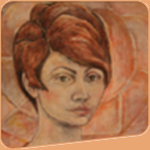(1947-1977)
A Profusion of Vibrant and Powerful Works
Ana María Cadaval



Toby Joysmith, Artist and Art Critic:
Facts become art through love which unifies them and lifts them to a higher plane of reality and, in landscape, this all-embracing love is expressed by light. This is as clear a description as we are likely to get of the last paintings of Ana
María Cadaval, for it is clear that, just before her untimely death in 1977, she was heading in precisely the right direction ― towards clarity, towards simplicity and towards light…
Her early work, while studying in Italy, is eclectic, searching, but emphasizing line― it was the setting free of this line that enabled her to make the giant stride forward in the later work. After her return from Europe to Mexico she is soon hard at work on still lifes and a series of portraits based on the figures of the Tarot cards.
Her next exploration was in landscape. Her influences were Graham Sutherland and Paul Nash ― lyrical painters of landscape and nature. From Sutherland she learned to make vital interlocking forms which cohered into a meaningful pattern. From Nash she took those subtle overtones that mark his surreal paintings where nature is transformed into something new and strange.
After a one-person show in Washington D.C., she visited New York where for the first time she saw Kandinsky at the Guggenheim. This was a revelation, for here was a painter who had trodden the same path that she herself was just beginning to follow: a juxtaposition of a vibrant line with patches or planes of clear color.
Soon after, she returned to Mexico where she saw the catalogue of the Turner watercolors at the British Museum in London. Turner showed her how to create a harmony between the expressionistic methods of Kandinsky and her own intimations about the value of light in painting.
“Landscape is, in itself, chaotic, transient, muddled and quite outside the life of reason,” Cezanne wrote to his lifelong friend Gasquet. Ana María Cadaval accepted this and embodied it in her method of painting.
She began by creating chaos of nature, scribbling with intuitive rapidity with a searching, searing, lightweight line from which, gradually, images began to appear. Then came the slow and often logical development of this chaos into a harmonized whole, juxtaposing vital line with many overlapping planes or touches of pure color. When the exact balance between chaos and order was reached the painting was finished.
In her last canvases, Ana María Cadaval achieved a haunting beauty where color, line, light, form, and content cohere to pass beyond the intrinsic quality of the painted surface itself. Here she reaches an ambiguity of statement which is the hallmark of great painting.
Toby Joysmith, artist and critic, Diccionario Biográfico Enciclopédico de la Pintura Mexicana: Siglo XX, Arte contemporáneo, 1978